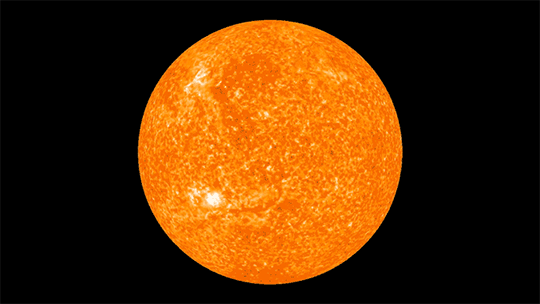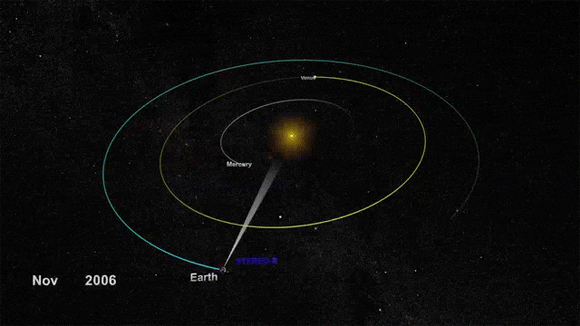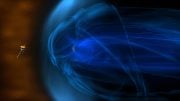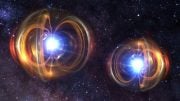Ten years ago the twin STEREO spacecraft joined a fleet of NASA spacecraft monitoring the sun and its influence on Earth and space – and they provided a new and unique perspective.
Launched 10 years ago, on October 25, 2006, the twin spacecraft of NASA’s STEREO mission – short for Solar and Terrestrial Relations Observatory – have given us unprecedented views of the sun, including the first-ever simultaneous view of the entire star at once. This kind of comprehensive data is key to understanding how the sun erupts with things like coronal mass ejections and energetic particles, as well as how those events move through space, sometimes impacting Earth and other worlds.
The two STEREO observatories, called STEREO-A and STEREO-B – for Ahead and Behind, respectively – were sent out from Earth in opposite directions. Using gravitational assists from both the moon and Earth, the STEREO spacecrafts were accelerated to Earth-escape velocities. STEREO-A was inserted into an orbit slightly smaller, and therefore faster, than Earth’s. For STEREO-B, the reverse happened: It was nudged into an orbit slightly larger than Earth’s so that it traveled around the sun more slowly, falling increasingly behind the Earth. As the spacecraft slowly fanned out away from the centerline between Earth and the sun – where every other sun-watching spacecraft is located – they revealed more and more new information about our closest star.
“STEREO gives us a much more thorough view of the sun, solar wind, and solar activity,” said Terry Kucera, deputy project scientist for STEREO at NASA’s Goddard Space Flight Center in Greenbelt, Maryland. “The view from the far side of the sun lets us record more events and get more complete pictures of each event.”
When observed through a solar telescope, the surface of the sun can be seen to be churning with near-constant activity, sometimes including the larger solar eruptions that can influence Earth, other worlds, and space itself. We call these changing conditions space weather. On Earth, space weather often manifests as auroras, or – in extreme cases – damage to satellites or stress on power grids.

This composite view shows the sun as it appeared on Jan. 31, 2011, with simultaneous views from both NASA’s STEREO spacecraft and NASA’s Solar Dynamics Observatory. These three distinct viewpoints allowed scientists to capture almost the entire sun at once, with only a small gap in data.
The prime STEREO mission was designed for two years of operations, observing the sun and the space environment around it, by which point the spacecraft would have traveled about 45 degrees (one-eighth of a circle each) away from Earth. This mission design was revolutionary, since our observations of the sun and conditions in space had previously been confined to views only from Earth’s perspective. By providing us with different views of the sun simultaneously, STEREO helped scientists watch solar eruptions develop over time, and gave them multiple perspectives of how those eruptions propagate outward. The greater the separation of the two spacecraft from each other and from Earth, the more we learned about the sun and its influence on space – including multi-point views of one of the most powerful solar storms on record.
“STEREO had unique perspectives of a powerful CME on July 2012, which was strong enough to cause serious disruptions if it had been Earth-directed,” said Joe Gurman, STEREO project scientist at Goddard. “We got a head-on look with STEREO-A, a side view with STEREO-B as well as observations by Earth-orbiting satellites.”
However, STEREO’s real windfall is the sheer amount of data collected. Both spacecraft functioned well for nearly eight years, yielding a treasure trove of data on solar events.
“Real science doesn’t come from just one event,” said Gurman. “The biggest advantage of STEREO is being able to validate our models of how CMEs move through space.”
STEREO-A continues to collect data. However, STEREO-B encountered an issue when the spacecraft approached a phase called superior conjunction – when the sun would stand between the spacecraft and Earth, blocking all communications. During testing in October 2014 to prepare for superior conjunction, contact with STEREO-B was lost. After nearly two years, on August 21, 2016, mission operators managed to contact STEREO-B once again, and have been in touch intermittently since then. This contact has revealed new information about the spacecraft’s battery and charge state, its position in space, its speed, and its spin – and mission operators continue to attempt recovery.
“The challenges for a successful recovery are many,” said Dan Ossing, the STEREO mission operations manager at the Johns Hopkins University Applied Physics Laboratory in Laurel, Maryland. “It’s an incremental process that continues to evolve, and could take months or even years. But we know enough of the spacecraft has survived to make these recovery attempts worthwhile. We just have to be patient.”

This animation shows the orbits of the two STEREO spacecraft from October 2006 to October 2016. Because of the twin probes’ unique positions in space, the STEREO mission has given scientists an unprecedented look at the sun, helping us to understand our home star.
Though STEREO-A was silent for nearly four months because of superior conjunction, after contact was re-established it returned the data recorded on the sun’s far side, filling in this gap in the timeline of solar data. The STEREO-A spacecraft is now operating fully, maintaining this stream of information.
“It’s these long term measurements that are critical for understanding the sun,” said Gurman.
STEREO is the third mission in NASA’s Solar Terrestrial Probes program, which is managed by NASA Goddard for NASA’s Science Mission Directorate in Washington. It was built by the Johns Hopkins University Applied Physics Laboratory in Laurel, Maryland.









Be the first to comment on "10 Years of Revolutionary Solar Views from NASA’s STEREO Mission"